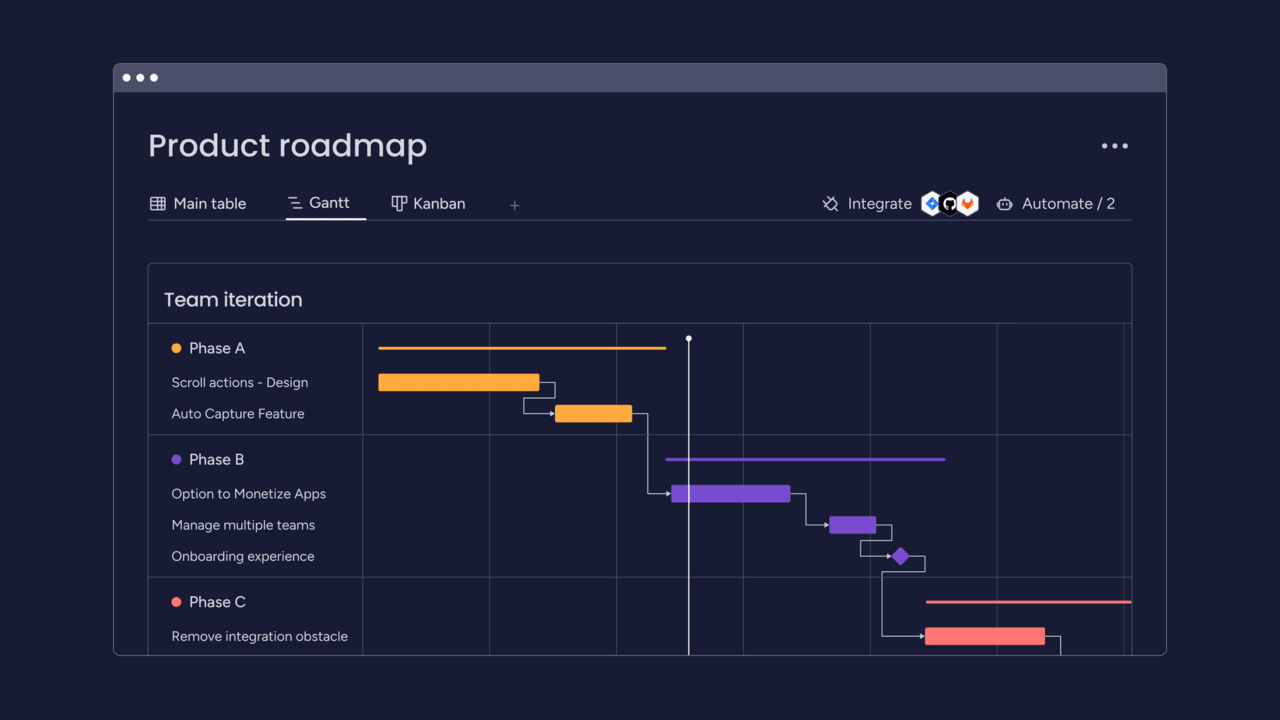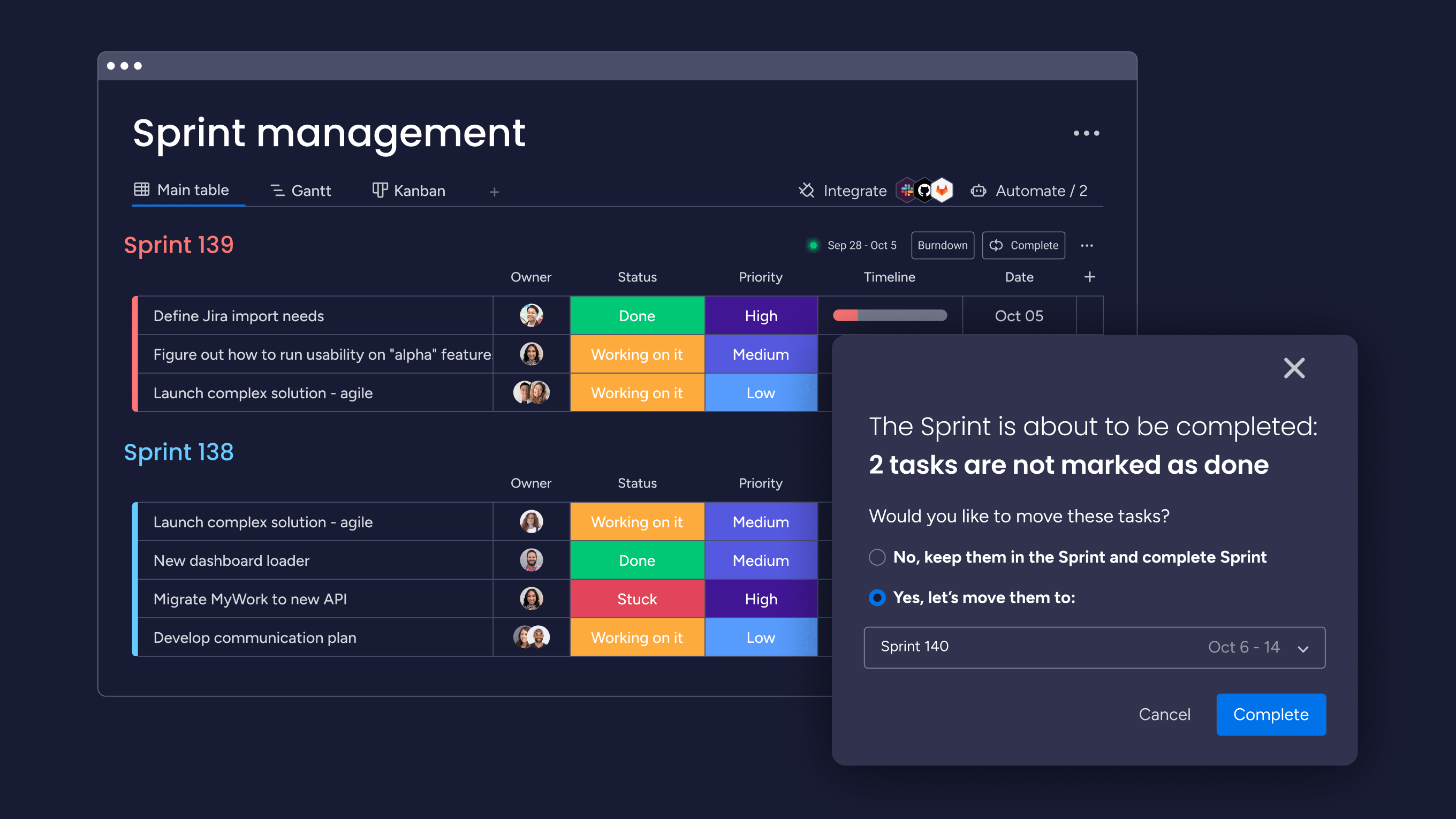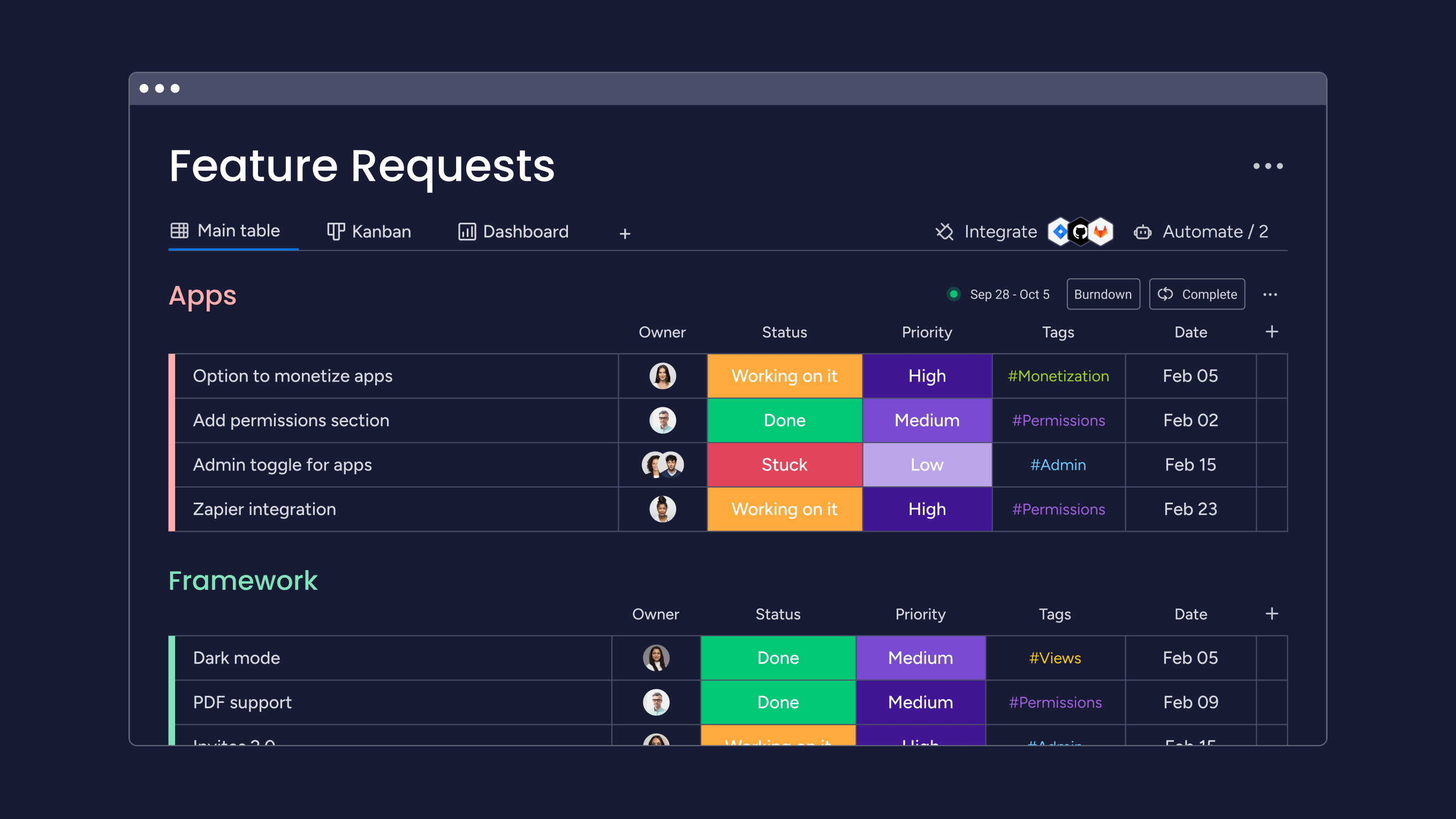It’s easy to lose track of the bigger picture when you’re working in Agile’s short, time-boxed sprints. But Agile epics ensure this doesn’t happen by connecting miniature tasks to your project’s overarching goals.
This guide explores agile epics in more detail, including examples, benefits, best practices, and how to write your own epics. We’ll also introduce monday dev as a platform to plan and track your entire agile journey from start to finish.
Try monday devWhat is an agile epic?
An agile epic is a substantial body of work that can be divided into smaller tasks known as user stories. These user stories all connect to each other like a web, to be completed as part of the overall epic. Both epics and user stories can (and should) be regularly tweaked and updated based on customer feedback to align them with user needs and project goals.
What is an example of an epic in agile?
Imagine your team needs to develop a new payment system as a key feature of a new mobile application. Your epic would include various user stories related to:
- Integrating with payment gateways
- Designing the user interface with various payment options
- Ensuring security compliance
- Testing the payment process
In this scenario, you could assign each of these user stories to specific team members or sub-teams for completion.
What are the benefits of using epics in agile?
Epics offer several distinct advantages to agile teams, including:
- Better project organization: At their core, epics are designed to be efficient. Breaking down complex projects into manageable chunks makes it easier to track progress, manage resources, and meet deadlines.
- Clear alignment with customer needs: Integrating client or customer feedback with your epic ensures the work always meets your target audience’s needs and expectations.
- Flexibility and adaptability: As priorities change or new information arises, you can adjust or re-prioritize your epics accordingly. By doing so, teams can respond quickly to new developments and keep projects on track.
- Improved communication: A clearly defined epic enables teams to communicate more effectively with a shared understanding of their project’s objectives and priorities.
How does an epic fit into agile management?
Epics form part of agile management’s hierarchy, which looks like this from the bottom up:
- User story: A single, specific request or requirement that describes a feature from the end-user’s perspective. It focuses on the “what” and “why” to ensure the team understands the desired outcome.
- Epic: An epic is a collection of related user stories that deliver key functionality or features when combined. It provides a larger narrative that ties the individual user stories together, ensuring they contribute to a common goal.
- Initiative: Multiple epics work towards achieving broader, strategic goals, often involving different teams and projects.
- Theme: These group initiatives and epics under common strategic directions or organizational goals.
Best practices for creating agile epics
Get the most value out of your epics by following these best practices:
Align epics with your OKRs and goals
Aligning epics with your existing OKRs and goals keeps everything focused and impactful. This alignment ensures all your work is meaningful and contributes to the organization’s strategic objectives.
Example: If your product management goal is to increase revenue by a specific percentage, your epics could align by focusing on new features or improvements to drive revenue growth. From here, your user stories will correspond to individual features that contribute to the epic’s success.
Write epics before user stories
Agile hierarchies can feel like a chicken-and-egg situation. Should you start at the top or the bottom? In most cases, it makes sense to write epics first (and initiatives and themes before those). Following this direction focuses the mind on your project’s goals and objectives, which makes writing user stories much easier.
Measure the success of your OKRs
Measuring epics tells you if your agile management strategy is working. Start with your high-level OKRs and see if you can track whether each epic is moving you closer to your targets. If you’re not making meaningful progress toward your objectives, it may be time to reevaluate the epic’s priority or its inclusion in the overall strategy.
Integrate customer feedback loops
Determine how you’ll collect customer insights and feed them back to your product and stakeholders to enhance your epics. You might conduct focus groups and use customer call transcriptions or surveys to keep you informed.
Use agile management software
The right agile management platform streamlines the process of creating and managing epics while tracking progress and communication within a team. These tools often offer backlog prioritization, sprint planning, and reporting to help teams stay organized, improve collaboration, and remain on track toward their goals.
Try monday devHow to write an agile epic
Writing an agile epic follows a similar structure to writing user stories. Here are the basic steps to follow:
1. Create a user persona or customer profile
Start by focusing on the product’s end-user or customer and understand their unique pain points. Ask key questions, such as:
- What is the top priority for the customer?
- What perspective does the customer bring to your product?
- How does your product assist them in solving their problems?
2. Define the epic’s overarching goal
Create specific goals for your epic that may relate to but slightly differ from your overall product strategy or roadmap. For example, your epic goal could be to improve user adoption rates for your new social media software, but your overall product goal could be to increase user engagement. Ensure your epic goal aligns with your organizational objectives and contributes to the larger picture.
3. Break down the epic into smaller, manageable tasks
While your epic can be broad, it’s important to break it down into bite-sized chunks, each of which is your user story. Continuing with the social media software example, if your epic is focused on increasing adoption rates, your user stories might be:
- As a new user, I want to be able to create an account easily.
- As a returning user, I want the app’s login process to be seamless and quick.
- As a power user, I want to be able to customize my profile for better personalization.
- As a business user, I want to be able to create and manage multiple accounts from one central dashboard.
4. Choose timeframes for your epics
Consider how long each epic will take to complete and prioritize accordingly. Some epics may be short-term, while others span multiple sprints or quarters. Remember that flexibility is key here, as priorities can change and estimations modified over time.
5. Set your acceptance criteria
Clearly outline what success looks like for each user story. What are the specific requirements and actions that need to be met? Communicating this ensures everyone understands when a user story is complete and that it meets quality standards.
Example: If your user story is “As a new user, I want to be able to create an account easily,” the acceptance criteria could be:
- The account creation process should take no more than 5 minutes
- The user must receive a confirmation email after creating their account
- The account creation form must have clear and concise instructions
Manage your next agile epic with monday dev
Agile epics and their related user stories must be kept organized, which is where monday dev comes in. Our powerful platform manages all aspects of product development from start to finish, making it the perfect place to host your epics.
From planning your product roadmap to overseeing and monitoring your agile sprints, monday dev empowers tech teams to work smarter, faster, and more collaboratively. Here are the specific features that will bring value to every piece of work in your next agile project:
- Roadmap planning: Create your agile epics with your overall strategy in mind. Our Roadmap Template lets you review your product development details according to your visibility preferences. For example, you might prefer to access a Gantt, Timeline, or Table View and set deadlines for completing your epics.

- Sprint management: Your epic’s user stories will closely correlate with different agile sprints. Use our Sprint Management template to keep these organized and on track.

- Feature backlog: Prioritize the list of deliverables you need to bring your product to life. This backlog forms an important part of your epic, defining what should be completed in each sprint.

- Bug tracking: Understanding any bugs or other obstacles in your product development can shape your epic and keep it on track. Using our Bug Tracking template for close monitoring, it’s easy to refine your epic and user stories so they remain relevant.

- Release planning: Use our Features and Releases template to map out your agile epics and user stories. Plan projects, prioritize major releases, and keep your entire team aligned using a visual and customizable board complete with 36+ columns and 27+ views.
Ready to go on an epic journey with monday dev? Take a free, no-obligation trial today.
Try monday devFAQs
What are epics in backlog?
A backlog epic organizes and prioritizes work within a backlog, making it easier for teams to focus on the most important initiatives. You can break each backlog epic down into smaller user stories that can be assigned and completed within a sprint. This agile approach allows for flexibility and adaptability while keeping the big picture in mind.
What are epics in SAFe agile?
In SAFe (Scaled Agile Framework), epics are used to capture large-scale initiatives that require analysis and a significant investment.
Should epics be in a sprint?
Epics are too large and complex to be included in a single sprint. However, the user stories that make up an epic can be assigned and completed within a sprint. This allows product teams to make incremental progress towards completing the overall epic goal.
 Get started
Get started 
